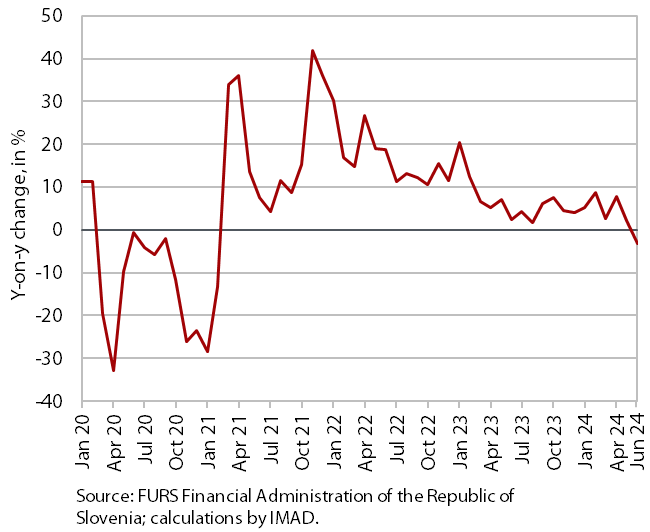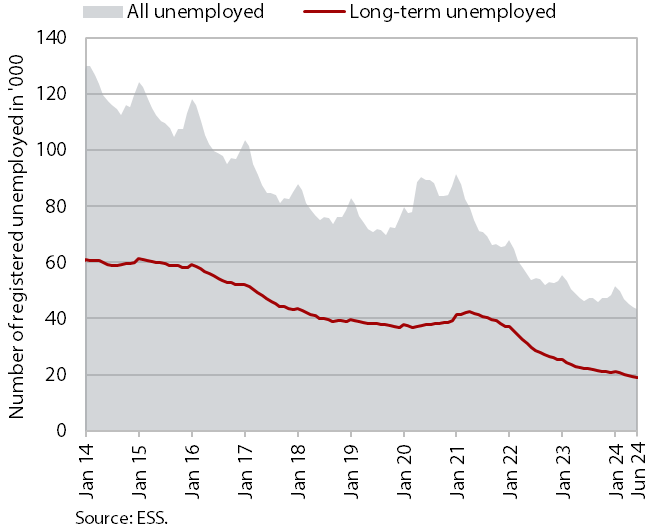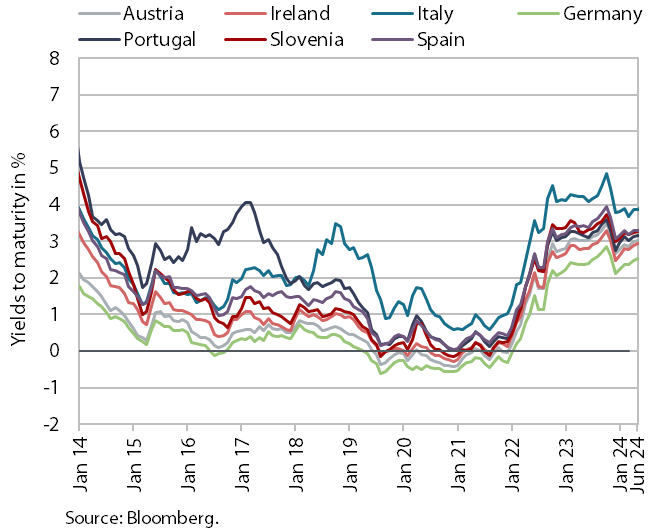Charts of the Week
Charts of the week from 1 to 5 July 2024: exports and imports of goods, value of fiscally verified invoices, unemployment and bonds
Real exports and imports of goods, which declined in May, were higher year-on-year in the first five months. In June, which had three fewer working days than the same month last year, the nominal value of fiscally verified invoices was lower year-on-year. In June, the decline in the number of registered unemployed was slightly less pronounced than in previous months. At the end of the month, 43,369 persons were registered as unemployed, 6.1% fewer than a year ago. Yields to maturity of euro area government bonds rose slightly in the second quarter.
Exports and imports of goods, May 2024

Real exports and imports of goods declined month-on-month in May but were higher year-on-year in the first five months; sentiment in export-oriented activities remained at a very low level. Real exports fell by 3.5% in May, due to lower exports to EU countries (-4.7%), especially to some of Slovenia’s main trading partners (Germany, Italy, Austria and France). On a month-on-month basis, exports were down in most main product groups, most notably in passenger cars. Imports fell by 5.7%, with imports from both EU and non-EU countries declining. Imports of intermediate goods and capital goods declined markedly (all seasonally adjusted). In the first five months, exports and imports of goods were on average higher year-on-year (by 1.0% and 1.3% respectively, original data). On the export side, especially exports to EU countries increased, while on the import side, imports from non-EU countries were higher. Sentiment in export-oriented activities deteriorated in June, with expectations for export orders falling to their lowest level this year.
Value of fiscally verified invoices, in nominal terms, June 2024

In June, which had three fewer working days than the same month last year, the nominal value of fiscally verified invoices was 3% lower year-on-year, while it was 2% higher overall in the second quarter. Turnover in June was lower year-on-year for the first time this year, due to a 4% year-on-year turnover decline in trade, which accounted for three-quarters of the total value of fiscally verified invoices. Turnover in wholesale trade fell by 12% year-on-year and turnover in the sale of motor vehicles by 8%, while turnover in retail trade was similar to June last year. Year-on-year turnover growth in accommodation and food service activities, certain creative, arts, entertainment, and sports services, and betting and gambling weakened significantly (overall growth in accommodation and food service activities and in other service activities was 4%, compared to 10% on average in the previous five months).
Unemployment, June 2024

The monthly decline in the seasonally adjusted number of registered unemployed in June (0.3%) was slightly less pronounced than in previous months. According to original data, 43,369 people were unemployed at the end of June, 6.1% fewer than a year ago. Amid labour shortages, the number of long-term unemployed (more than one year) and the number of unemployed over 50 fell year-on-year at the end of June, by 13.9% and 9.1% respectively. In the first half of the year, just over 1% of the unemployed moved to inactivity or retirement each month, also contributing to the decline in unemployment.
Bonds, Q2 2024

Yields to maturity of euro area government bonds rose slightly in the second quarter. In this period, the yield to maturity of the Slovenian government bond increased by 12 basis points, to 3.28% compared to the previous quarter. The spread to the German bond narrowed slightly, reaching 78 b.p., the lowest level since the beginning of 2022.
